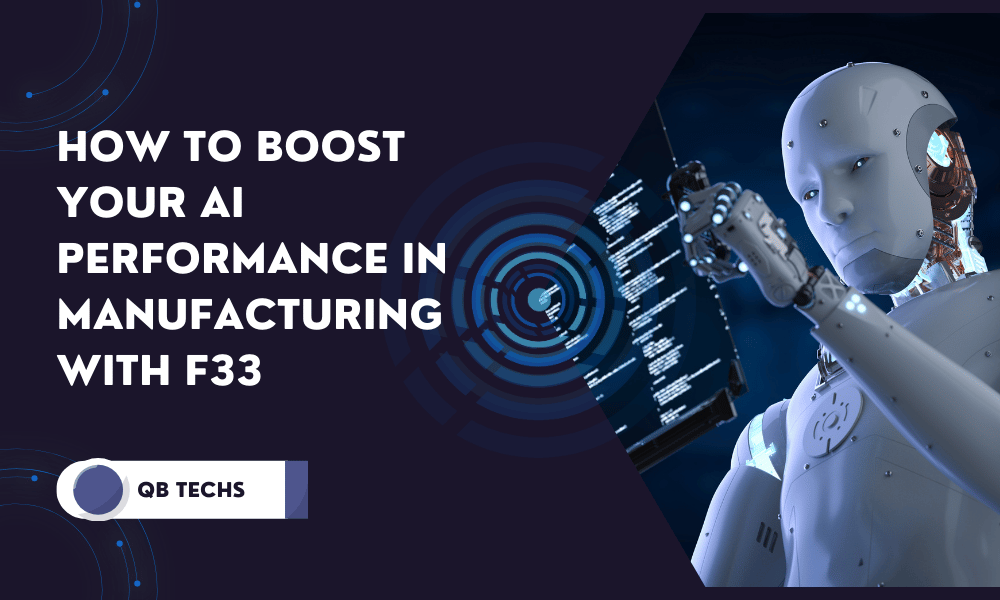However, with an effective implementation of AI in the manufacturing unit there has been a drastic increase in the overall productivity of the firm which has ultimately taken the business to higher levels. The F33 framework is the latest advancement in the field of AI, and it has specifically offered the latest advancements for manufacturing processes. Through this blog post, we intend to make our readers aware of the points that need to be considered to know how to Boost Your AI Performance in Manufacturing with F33.
Understanding F33: A Brief Overview
F33 is the most innovative form of AI framework that is specifically designed for optimizing the machine learning models, specifically the complex and data-intensive environments like manufacturing. It combines advanced algorithms, enhanced computational techniques, and robust data handling capabilities for providing superior performance. Listed below are some of the key features of f33.ai include:
- Scalability: The F33 framework holds the ability to manage huge data sets and scale computational resources meticulously.
- Speed: The F33 framework has boosted up the training and inference times by using highly optimized algorithms.
- Accuracy: F33 have enhanced the rate of accuracy of models by incorporating advanced techniques like ensembling learning and hyperparameter tuning.
- Flexibility: The F33 framework is Compatible with multiple AI and machine learning libraries and tools.
Key Areas Where F33 Can Enhance AI Performance in Manufacturing
Listed below are some of the key areas where F33 can improve the performance of the manufacturing unit.
1. Predictive Maintenance
Predictive maintenance is the most significant application of AI in the field of manufacturing. By estimating the failures of the equipment before they actually occur, manufacturers can minimize the downtime and maintenance costs. The F33 primarily enhances the predictive maintenance by:
- Processing Large Volumes of Sensor Data: The scalability of F33 enables it to process the data efficiently by using numerous sensors in real-time and ensuring the timely predictions.
- Improved Anomaly Detection: The F33 framework has highly advanced algorithms that can effectively detect the minor inaccuracies that might get missed by using traditional methods hence leading to higher productivity of the firm.
2. Quality Control
The most crucial aspect in manufacturing is to ensure that the quality of the product meets the standards. AI-powered quality control systems are highly effective at identifying the defects and ensuring compliance with standards. The F33 framework contributes to this niche by:
- Enhanced Image Processing: The highly optimized algorithms of the F33 framework enhances the overall speed and accuracy of image recognition tasks. This feature is majorly used for detecting the defects in the products. Incorporating an AI picture maker into your manufacturing workflow can significantly enhance product visualization and streamline design processes. For instance, Bosch utilizes generative AI to create synthetic images of potential defects, enabling early training of quality inspection models and improving overall production quality.
- Adaptive Learning: The flexibility of the F33 framework enables businesses to adapt new types of defects and develop the quality standards over time hence ensuring a consistent and continuous enhancement in the quality control processes.
3. Supply Chain Optimization
Efficiency in supply chain management is crucial for businesses, specifically the manufacturing units for reducing the overall costs and meeting the demands of the customers effectively. AI is specifically meant for optimizing numerous aspects of the supply chain management, and the F33 framework enhances it further by:
- Advanced Forecasting: The superior model accuracy of the F33 framework leads to higher and precise demand forecasting, minimizing the cost of inventory and preventing the situations of stock outs or overstocks.
- Dynamic Optimization: The advanced framework of F33 is effective at handling the complicated optimization related issues which includes multiple variables and constraints, which results in higher efficiency of routing, scheduling, and inventory management.
4. Process Automation
Automating the repetitive and labor-intensive processes is another significant benefit of AI in the field of manufacturing. F33 boost up the process of automation by:
- Robust Data Handling: The ability of the F33 framework to manage huge sets of data ensures that automation systems have access to accurate and holistic data for decision-making.
- Real-Time Processing: The speed of the F33 framework has enabled the real-time decision-making that is crucial for automated systems that require quick responses to changing conditions.
Implementing F33 in Your Manufacturing Operations
By using the methods listed below businesses can implement F33 in their business operations:
1. Assess Your Current AI Capabilities
Examine your current AI infrastructure and look for further areas of enhancement. This evaluation will assist you to comprehend how the F33 framework will address the issue you are facing.
2. Invest in Training and Development
Make sure that your team is well-aware of the F33 framework and its implementations. Investing in training and development programs automatically increases the benefits of F33 and facilitates a smoother implementation process.
3. Collaborate with Experts
Collaborate with AI and machine learning experts who hold a good experience with the F33 framework. Their experience in this niche will be invaluable in designing F33 to meet the unique manufacturing needs of your business and overcoming the challenges.
4. Monitor and Optimize
Businesses can effectively monitor the performance of their AI systems continuously after implementing the F33 framework. Leverage the insights to make the necessary adjustments and optimizations and for ensuring that you achieve the desired performance improvements consistently.
Future Trends and the Role of F33 in Smart Manufacturing
Furthermore, the collaboration of F33 within the smart manufacturing ecosystems has entirely revolutionized the manufacturing industry. As the manufacturers continue to implement the latest advancements, the demand for AI frameworks like F33 will also expand. The ability of the F33 framework to integrate with IT devices seamlessly, big data analytics, and cloud computing will drive unprecedented levels of automation and intelligence.
In addition, the implementation of the F33 framework for real-time analytics and decision-making has empowered the manufacturers to adapt to latest alterations of the market, optimize the allocation of resources, and enhance the efficiency of production. By using the F33 framework, businesses can not only achieve operational excellence but can also streamline their operations hence setting new benchmarks for the upcoming manufactures.
Challenges in Implementing F33 in Manufacturing
Manufacturers need to be aware of these potential obstacles to effectively leverage the technology. Alongside the benefits, the F33 framework offers a few challenges as well. Below is the list of challenges that businesses need to be aware of:
1. High Initial Investment
By implementing the latest F33 framework requires a substantial initial investment in hardware, software, and training. High-performance computing resources are essential to utilize the capabilities of the F33 framework, which can be comparatively costly. Furthermore, integrating F33 with the existing systems might need certain infrastructure upgrades.
2. Complex Integration Process
Integrating the F33 framework with the existing manufacturing systems is a complicated and rigid procedure on its own. Manufacturers must make sure that the F33 framework is compatible with their current technology stack and can interact with various sources of data seamlessly, and machinery. This integration often demands specialized knowledge and expertise, posing a challenge for companies without in-house AI experts.
3. Data Quality and Management
The effectiveness of F33 heavily relies upon the quality and volume of the available dataset. In manufacturing, the data is widely distributed hence making it a difficult task to integrate, clean, and manage. Poor quality of data might lead to inaccurate predictions hence undermining the potential benefits of the selected framework.
4. Skill Gaps
Leveraging and maintaining the F33 framework demands specialized skills in AI, machine learning, and data science. There are multiple manufacturing companies that lack skilled professionals and the ones who can effectively develop, deploy, and manage the AI solutions. This skill gap can affect the precise utilization of the F33 framework and delay the realization of its benefits.
Conclusion
The F33 framework represents a significant advancement in AI technology, offering numerous benefits for manufacturing operations. By enhancing the predictive maintenance, quality control, supply chain optimization, and process automation, F33 can propel consistent enhancements hence increasing the efficiency and overall performance of the manufacturing unit. Leveraging the F33 framework demands careful planning, investment in training and development programs of the workers, and collaboration with experts of this niche.




Leave A Comment
You must be logged in to post a comment.